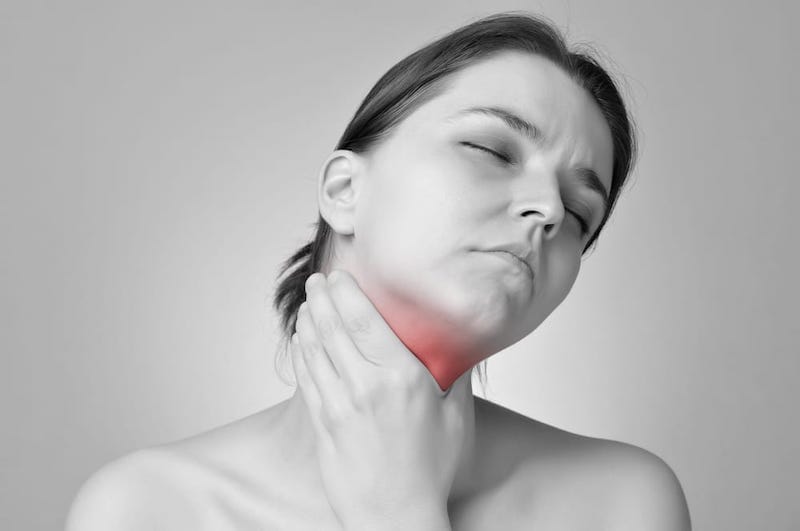No technique works for everybody in popping the hyoid bone back in place. However, you can try to push your hyoid bone or the muscles near it until you feel it pops back into its position. If the shifting of your hyoid bone causes you pain, difficulty breathing or swallowing, tenderness in the area, and other unusual symptoms, this is a medical emergency. Most problems on the hyoid bone don’t always require surgery. Doctors would recommend you to receive NSAID therapy first, along with anesthetic and corticosteroid injections.
Have you ever heard of the hyoid bone?
If you’re an avid fan of thrillers and crime novels, then you must know that the hyoid bone plays a significant role in a post-mortem examination.
A fractured hyoid bone would indicate strangulation as the cause of death in most homicide and suicide victims.
The hyoid bone is a pretty unique bone to the rest of the bones in your skeletal system.
Wondering why? We’ll talk more about it below!
What is hyoid bone?

Unlike other bones in your body, the hyoid bone is not directly connected to your other bones. It kind of floats freely and is only held in place by a large number of muscles found on your front neck.
It forms a U shape, kind of like a horseshoe.
The term hyoid came from the ancient Greek word “hyoiedes,” which means u-shaped or upsilon-shaped (u).
The hyoid bone is located on the upper front part of your neck between your chin and thyroid cartilage. It holds up your tongue, which sits on top of it.
Well, it’s basically called tongue bone or lingual bone.
Aside from your tongue, it also serves as the attachment site of several muscles in your front neck. These include the muscles of your mandible, skull, thyroid cartilage, pharynx, sternum, and shoulder blade.
Hyoid bone supports the movement of your tongue and other functions like chewing, vocalizing, breathing, and mainly swallowing.
Can I move my hyoid bone from side to side?
Yes, you can palpate your hyoid and move it side-to-side.
To locate your hyoid bone, slightly tilt your head backward. Using your thumb and index finger, find your Adam’s apple. Then, slide your fingers above it until you feel a sharp or pointy part; right there is your hyoid bone.
The hyoid bone is right underneath your jaw. You can squeeze it and move it side-to-side. It’s not very pleasant, so do it gently.
Can you dislocate your hyoid bone?

Because of its location and highly movable structure, you can’t easily dislocate nor fracture your hyoid bone.
It’s very well-protected by your mandible and cervical spine.
Most injuries on the neck often result in damage to the structures protecting your hyoid bone rather than dislocating the hyoid bone itself.
Researchers say that hyoid bone fractures are much more common than dislocations. Fractures are still extremely rare, with only a few cases reported worldwide.
Most of these reports are autopsy findings from victims of strangulations or hanging.
A dislocated hyoid bone can result from:
- Direct trauma or injury to your neck through manual strangulation, throttling, or hanging.
- Blunt trauma due to a motor or car accident, sports injuries, or impact from projectiles (like a softball hitting your neck so hard).
Symptoms of a hyoid bone injury
Sometimes, a fractured or dislocated hyoid bone may not give you any symptoms. If it does, symptoms may include the following:
- Discoloration under your skin- reddish or blackish blue to yellow or green discoloration (neck ecchymosis)
- Pain when swallowing (odynophagia)
- Swelling and tenderness in the neck
- Coughing up blood or mucus with blood (hemoptysis)
- A cut or open wound on your neck (pharyngeal lacerations)
- Crepitus or weird creaking, grinding, crackling, or popping sounds when moving the neck
- Pain on rotating the neck
- Difficulty swallowing or dysphagia
- Your voice becomes hoarse or raspy (dysphonia)
- Squeaking or whistling sound when breathing (stridor)
- Difficulty talking and breathing
What is a hyoid bone syndrome?
Hyoid bone syndrome or hyoid syndrome occurs when there are abnormalities in the structure of your hyoid bone, specifically the greater cornua.
This syndrome often results from trauma causing direct damage to the structure. It could also happen that abnormalities develop on the tendons, muscles, and ligaments that insert onto it, resulting in pain in your hyoid bone.
The hyoid syndrome may cause pain in your upper front neck, especially when swallowing.
Pain may radiate to your ear, face, lower jaw, pharynx (throat), and even on upper regions of your chest, clavicle, shoulder, and arms.
This radiating pain explains the muscular connections of your hyoid bone to these regions.
Other symptoms may include but aren’t limited to the following:
- Sharp, stabbing pain when moving your jaw, chewing, rotating your neck, or swallowing.
- Difficulty in speaking clearly (dysphonia)-often characterized by your voice sounding hoarse, raspy, strained, or weak.
- Feeling like something is stuck in your throat
- Pain and tenderness when palpating the location of the greater cornua of your hyoid bone
Diagnosis and treatment of the hyoid bone syndrome
Although the hyoid bone syndrome isn’t a well-recognized pain syndrome, it’s very real. It may affect anybody whose neck is frequently exposed to trauma or a sudden injury.
Treatments for this condition are available but diagnosing it could be challenging.
Most patients with hyoid syndrome take a long time before getting diagnosed and receiving proper treatment. That is because problems with your hyoid bone could mimic other diseases.
Your doctor may prescribe you oral non-steroidal inflammatory drugs and/or ointments as first-line treatments for suspected hyoid bone syndrome.
Further testing and invasive treatments are necessary when symptoms persist or worsen.
NSAID therapy might provide you significant relief if you had the symptoms no later than six weeks.
If your doctor finds abnormalities on your hyoid bone through further diagnostic testing (i.e., digital and bimanual palpation), they will give you a local anesthetic to see whether your symptoms vanish.
After receiving a local anesthetic, signs of pain relief will further support hyoid syndrome as a diagnosis. Your doctor may require you to take another anesthetic shot and corticosteroid injections to see if your symptoms resolve completely.
If your symptoms reappear, you will need an endoscopy and CT or MRI scan.
Results of these imaging tests will help your doctor confirm your diagnosis before suggesting to do surgery.
How does hyoid bone syndrome occur?
A hyoid bone syndrome is a very rare condition, and it will take some time before you get diagnosed with it.
It may have occurred when you were born, or it could have been acquired due to several factors like the following:
- Oral habits or problems that affect the hyoid bone position
- History of previous trauma and inflammation
- An effect of surgical treatment on areas near your hyoid bone
FAQs
Can your hyoid bone pop out of place?
Yes. Many people experience their hyoid bone shift/click in a weird position. It usually feels like having your throat or neck pop out of place.
It can sometimes happen when you’re eating or swallowing, talking, shouting, moving your neck, or even without doing anything. It’s usually not life-threatening unless it causes choking or gives you intense pain.
The internet won’t give you many techniques for popping your hyoid bone into its position. But, you could try these steps below:
– Push the hyoid bone or its surrounding/connecting muscles until you feel it goes back into its place.
Another method you can try is:
– Tuck your chin in, flex or tense your neck muscles hard and use your fingers to feel your Adam’s apple and push around it until you hear your hyoid bone click.
A hyoid bone shifting out of place needs immediate medical attention. Please schedule a check-up with your ENT or a bone specialist.
Can you move your trachea from side to side?
You shouldn’t attempt to move your airways from side to side. Doing so may stir up problems and may cause malfunctions or damage.
Most people with Ehlers-Danlos Syndrome report having flexible or movable trachea. Purposefully moving your trachea isn’t a very wise thing to do.
However, some adult or older people may experience their trachea shifts out of normal position, causing their neck or throat to look lopsided.
This medical condition may indicate a tracheal deviation, a symptom of some chest, neck, and lung conditions.
Please seek medical assistance immediately when you notice signs of a shifted trachea.
Can you survive a broken hyoid?
A broken hyoid bone isn’t always fatal. Still, it’s considered a medical emergency, especially if it’s giving you severe symptoms.
These symptoms may be difficulty swallowing and breathing, intense radiating pain from your upper neck to your chest, coughing up blood, and pharyngeal lacerations.
A broken or fractured hyoid bone could be hard to detect, but treatments are available. Getting diagnosed early will prevent further complications from occurring.
You’ll also have higher chances of healing from receiving conservative and non-surgical treatments.
Conclusion
The hyoid bone is well-protected in your front neck. Its location and structure keep it from getting major damage when your neck is exposed to any physical trauma.
A broken hyoid bone may not always be life-threatening. But, this requires immediate medical attention for you to receive early diagnosis and first-line treatments.
Recurring problems in your throat that don’t seem to resolve despite many tests and treatments could mean problems in your hyoid bone.
Please schedule a check-up with an ENT or a bone specialist if you notice your throat popping out of place, giving you severely life-threatening symptoms.


